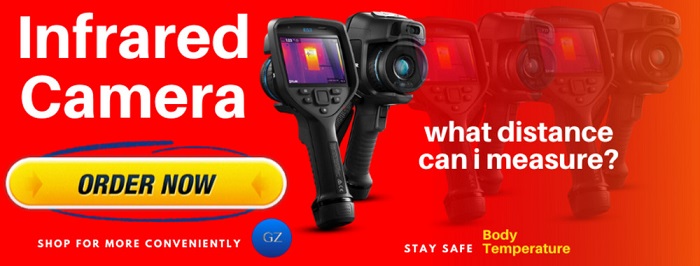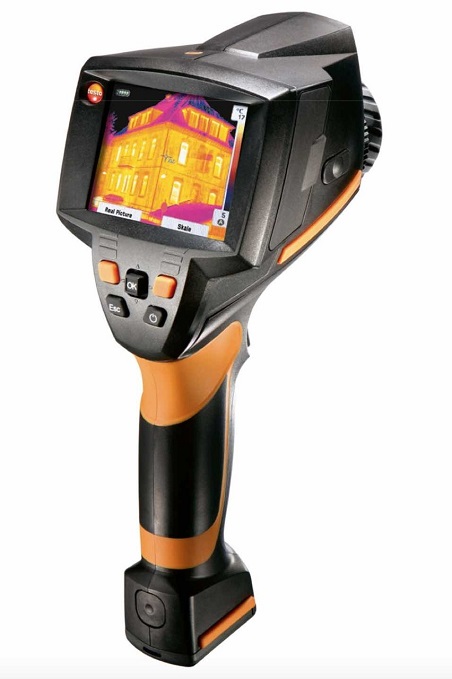Distance to Measure Body Temperature with Infrared Camera
Distance to Measure Body Temperature with Infrared Camera
An imaging system is generally composed by a collector (usually lenses and/or mirrors), filters, detector, processor, a system for data storage and an output unit. They are tools used for detection, location, identification and recognition. The output can be a monitor that provides an image of the collected electromagnetic radiation. The operational wavelength range of the imaging systems is usually between 0.35 and 15 µm. In addition, every electro-optical system has its unique characteristics and some internal parameters to be settled, which directly implies on the quality of the images to be acquired. This quality may or may not be suitable for target location, identification and/or recognition under certain environmental conditions (atmospheric, altitude etc.) or the scenario in which the target was encompassed.
An infrared thermometer is a thermometer which infers temperature from a portion of the thermal radiation sometimes called black-body radiation emitted by the object being measured. They are sometimes called laser thermometers, as a laser is used to help aim the thermometer, or non-contact thermometers or temperature guns, to describe the device's ability to measure temperature from a distance. By knowing the amount of infrared energy emitted by the object and its emissivity, the object's temperature can often be determined within a certain range of its actual temperature. Infrared thermometers are a subset of devices known as "thermal radiation thermometers".

Infrared light works like visible light--it can be focused, reflected or absorbed. Infrared thermometers usually use a lens to focus infrared light from one object onto a detector called a thermopile. The thermopile absorbs the infrared radiation and turns it into heat. The more infrared energy, the hotter the thermopile gets. This heat is turned into electricity. The electricity is sent to a detector, which uses it to determine the temperature of whatever the thermometer is pointed at. The more electricity, the hotter the object is.
Sometimes, especially near ambient temperatures, readings may be subject to error due to the reflection of radiation from a hotter body—even the person holding the instrumentrather than radiated by the object being measured, and to an incorrectly assumed emissivity.
Infrared thermometers are characterized by specifications including accuracy and angular coverage. Simpler instruments may have a measurement error of about ±2 °C or ±4 °F.
The distance-to-spot ratio (D:S) is the ratio of the distance to the measurement surface and the diameter of the temperature measurement area. For instance, if the D:S ratio is 12:1, the diameter of the measurement area is one-twelfth of the distance to the object. A thermometer with a higher ratio of D to S is able to sense a more-specific, narrower surface at a greater distance than one with a lower ratio. A 12:1 rated device can sense a 1-inch circle at a distance of one foot, whereas a 10:1 ratio device achieves the same 1-inch circle at 10 inches, and a wider, less-specific circle of 1.2 inches at a distance of 12 inches.

The ideal target area should be at least twice the size of the spot at that distance, with smaller areas relative to distance resulting in less accurate measurement. An infrared thermometer cannot be placed too close to its target, or this proximity causes heat to build up in the thermometer's housing and damages the sensor. Measurement error generally only decreases with too much distance because of the effects of reflectivity and the inclusion of other heat sources within the sensor's field of view.
According to the Stefan–Boltzmann law, radiant power is proportional to the fourth power of temperature, so when the measurement surface has both hot and cold areas, the indicated temperature may be higher than the actual average temperature, and closer to fourth-power mean average.
Most surfaces have high emissivity (over 0.9 for most biological surfaces), and most IR thermometers rely on this simplifying assumption; however, reflective surfaces have lower emissivity than non-reflective surfaces. Some sensors have an adjustable emissivity setting, which can be set to measure the temperature of reflective and non-reflective surfaces. A non-adjustable thermometer may be used to measure the temperature of a reflective surface by applying a non-reflective paint or tape, with some loss of accuracy.
A sensor with an adjustable emissivity setting can also be used to calibrate the sensor for a given surface or to measure the emissivity of a surface. When the temperature of a surface is accurately known (e.g. by measuring with a contact thermometer), then the sensor's emissivity setting can be adjusted until the temperature measurement by the IR method matches the measured temperature by the contact method; the emissivity setting will indicate the emissivity of the surface, which can be taken into account for later measurements of similar surfaces (only).
In knowing what distance you can measure, understanding spot-size ratio is important. This is a number that tells you how far you can be from a target of a given size and still get an accurate temperature measurement with a thermal camera. For the most accurate temperature measurement, it is necessary to get as many pixels from the camera’s detector as possible onto the target. This will give more detail in the thermal image. As the camera moves farther and farther away from the object being measured the ability to measure temperature accurately is reduced. The higher the resolution the camera has, the more opportunity there is to get more pixels on a target from farther away with accurate results. Digital zoom doesn’t improve accuracy, so higher resolution or narrow field of view is key. This single-pixel measurement is called ‘theoretical spot size ratio’. Some manufacturers list theoretical spot size ratio in their product specifications. While this may be considered the true spot size ratio, it can be misleading because it is not necessarily the most accurate. This can be because it only gives the temperature of a very small area within a single pixel. As previously mentioned, it is important to get as many pixels as possible on the target to ensure accuracy. One or two pixels may be enough to qualitatively determine that a temperature difference exists, but it may not be enough to provide an accurate representation of the average temperature of an area.

A single pixel measurement may be inaccurate for various reasons:
You can measure a 20mm spot from approximately 5m away from the target with your 320 x 240 resolution camera. Ultimately, spot size ratio matters because it helps to demonstrate whether a thermal camera is capable of accurately measuring temperature at the distances required. When measuring small targets from long distances, knowing the spot size ratio of the camera and whether you are standing within accurate measurement range is crucial.
Infrared camera can be used to measure temperature of any surface and also human body temperature
Feel free to Contact Us for expert advice and available products.
Recent Posts
-
Press Release: Same Great Lube, Less Waste: Lubemax 50:50 makes the Switch to Sustainable Packaging
In a move towards environmental responsibility, Epoxy Oilserv Nigeria Limited is proud to announce t …Apr 23, 2024 -
Top 8 Generators Recommended by Professionals in Nigeria (Reviews)
Generators can keep your home or business running with your essential equipment until the power is b …Apr 23, 2024 -
Transformer Safety: Preventing and Managing Common Hazards
Transformers are critical components in the electrical distribution system, handling high volt …Apr 23, 2024



